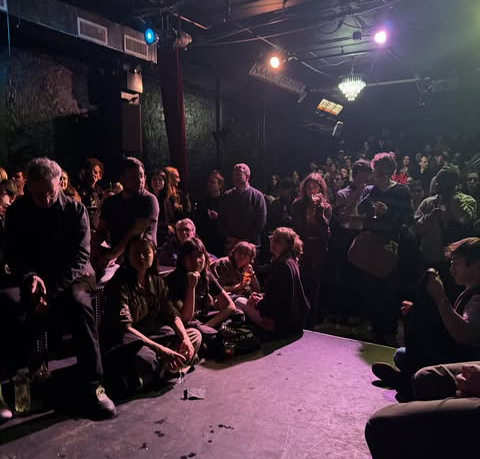 Alex Kitnick
Alex Kitnick
This text was performed as part of the event MANIFESTO!, held on March 19, 2025, at KGB Bar in Manhattan.

An eager crowd assembles to hear Alex Kitnick.
When I think about the social function of art, I think about the subway. I think about people clustering, gathering, shuffling, and moving, and then I think about all the cars linked together—eight, nine, ten, eleven at a time. I remember, too, that another train will arrive minutes later, and that the F is only one of many lines crisscrossing the city, twenty-four hours a day. When I think about all this, art—and the audience for art, which includes the audience for criticism—seems fairly small. I think about Poetry in Motion.
Maybe scale isn’t the metric by which we should consider art, but art does need some kind of world in which to operate. In one of his early talk pieces, the poet David Antin describes New York in the 1960s:
there were millions of people all around and most of them seem to have been artists of some sort or another maybe i was mistaken but it seemed to me there were all sorts of artists there were many more artists than there were audiences which was all right artists went to see each other’s work and we were all very excited with everything we were doing and we were all doing everything . . . and everybody was an art critic all artists were art critics
This is something of a fantasy, of course, but Antin’s anecdote helps us imagine what it must have felt like to live in a deeply involving art world thick with looking, watching, making, writing, reading, talking, and listening. It wasn’t so much that there wasn’t an audience for art at this moment as much as artists were the audience—and the critics, too. Antin’s idea echoes the central sentiment in Oscar Wilde’s great dialogue of 1891, “The Critic as Artist,” which has the savvy Gilbert proclaim that Greek art rose to such immense heights because “the Greeks were a nation of art-critics.” Having lots of critics around and creating an environment of criticism is understood in both cases as having been a rather positive thing.
Central to Antin and Wilde’s understanding of these two urban art worlds, separated by however many millennia, is that the critical function wasn’t siloed off, professionalized, and assigned to people who were only and ever critics, but rather that it belonged to and was practiced by everyone, especially artists. Today we say such a thing pejoratively: “Everyone’s a critic” means that no one is, that everything has been leveled, that judgment has been suspended or that its enormity has given way to equilibrium. But it’s important to push this thought against the grain and imagine that criticism can only exist when everyone, or at least a critical mass of people, are actively involved in the culture of art. Criticism is better when more people take part in it. Differences can be compared; alliances can be made, broken, reworked; ideas gel; some kind of common-enough language and criteria might be established. This community aspect is important for language and discourse to take shape. Criticism and community, then, are deeply entwined.
Certainly many (maybe millions of) people are involved in the culture of art today, and there are almost too many art worlds to count, and yet we’re living in a space quite different from 1960s New York or Ancient Greece. Is the professionalization of art criticism to blame? Did art criticism siphon off a wider world of critical energy, leaving the latter depleted? I hope not; probably not; I don’t know, but I think art critics as we know them today might have some positive contribution to make in creating worlds of art, even though many now consider the critic to be an historical category. (See Eagleton, Buchloh, etc.)
So, what might be the role of criticism, and the critic, in creating worlds of art? Criticism addresses a world, or at least it imagines an audience that might be addressed. It might have less to do with changing the world, in other words, than with constituting, or focusing, worlds. It does this by holding up tent posts in which art and conversation might convene. (And so, publishing criticism, or making criticism public, is an important part of the equation, especially as the platforms for art become more digital and less bound by locale. That said, art, to some extent, might always be a local phenomenon.)
Criticism has some inextricable relationship with judgment, but perhaps more importantly, it opens up a space for complexity; it creates conditions for questioning the doom and resisting the hype, offering an alternative set of values to those held up by the market and the vibe. Criticism, then, is less about offering a final verdict on an artwork’s value than it is involved with creating linguistic material—words, phrases, and positions—that can be used in bars, classrooms, studios, and subway cars. At least this is the aspiration—to keep the conversation going. The question I don’t have the answer for is how to do this when all forces are against it—how to pay, in other words, for the critical life. (For me, simply knowing that someone somewhere is being critical is extremely inspiring.) I realize I am running the risk of sounding heroic but I don’t much like the alternative: an endless stream of likes; a wave of burns without any rhyme or reason.
Alex Kitnick teaches art history at Bard College in Annandale-on-Hudson, New York.